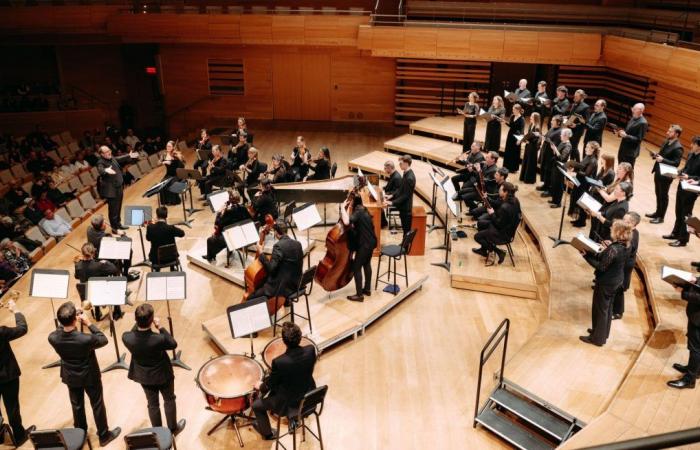Saturday evening, Arion performed for the first time in its history at the Maison symphonique, while the Studio of Early Music of Montreal (SMAM), with which the baroque orchestra was associated, celebrated its 50th anniversary in a program mainly composed of music for the coronations of George II and George III in the 18th centurye century. The evening gave the conductors of both ensembles the opportunity to showcase their personalities.
“At the time, we played this for the king; Tonight is for you! » Andrew McAnerney’s sympathetic address to the public delicately reframed the subject of the evening, of English royal splendor, a choice perhaps a little monolithic and not “popular” enough in Quebec for the occasion of a first presence of the Arion-SMAM tandem at the Maison symphonique.
It is hard to believe that by adding the audiences of the various Arion presentations in Bourgie to those of the SMAM, we would only reach this large half-parterre of Maison symphonique, undoubtedly quite disappointing for the organizers. Because baroque and classical choral music of this level obviously has its place at the Maison symphonique, where it would even be very interesting to have an alternation of Violons du Roy / Chapelle de Québec and Arion / SMAM, since, like the Mathieu Lussier clearly showed in one of these little effective and witty presentations of which he has the secret, the nature of the instruments differs and makes Arion unique.
Two phases
There was therefore a contrast between the 40e anniversary of the Violons du Roy, Friday in Bourgie, compact, intense and “family”, and this 50e SMAM anniversary, Saturday, more scattered at the Maison symphonique, and therefore more diffuse and measured.
Certainly both parties also offered opposition, the first being led by Andrew McAnerney, director of SMAM, the second by Mathieu Lussier, director of Arion. In Zadok the Priest (Anthem HWV 258 by Händel), McAnerney does not indulge in any particular effusion or exaltation. The modest numbers do not allow us to overplay the grandiose either. The chef therefore frames everything with nobility. He is perfectly in his element sculpting the lines of the two Anthems by Byrd and Weelkes which follow, a cappella works from the turn of the 17the century.
The King Shall Rejoicefirst of three Anthems for choir and orchestra by Boyce for the coronation of George III (1761) is, in its scale and quality, a revelation of this program. Andrew McAnerney has the group well in hand and tames the excellent homogeneity and balance of SMAM’s voices. His peaceful personality magnificently succeeds in a tender and undulating passage “Kings’ daughters were among thy honorable women” from theAnthem « My Heart Is Inditing » HWV 261 by Handel. We thank McAnerney for thinking of SMAM founders Christopher Jackson, Réjean Poirier and Hélène Dugal this evening.
The much more ebullient character of Matthieu Lussier gave us a Royal Fireworks Musik lively and jubilant, bouncing but for a good cause. The choices of tempos and agogics were the right ones. The general color favored the brilliance of the trumpets, placed in front on the right, while the three oboes were at the back in the center of the orchestra. We dreamed of hearing this chef address the Anthems HWV 259 et 260 in this state of mind and with this momentum. Unfortunately the after-effects of a recent respiratory illness, in particular the extremely growing risk of disrupting the concert with irrepressible coughing fits, had to make us leave prematurely for health reasons.
But certainly the outcome was established: the place of these ensembles in this place is very legitimate and brings something on a musical level, since Bourgie is too small for these numbers and the acoustics are better than that of a church. On the other hand, we must think about “making it known”, even if it means wondering whether we should not do a “Baroque at the Maison symphonique” season of 6 or 7 concerts, shared between various organizations, with a pooling of dedicated means to work on a season, an audience, subscriptions or series, which would feed a baroque “general public” (or at least direct occasional consumers towards the most valuable ensembles), the increase of which could then feed the audience more “specialized” projects.
To watch on video
#Canada






